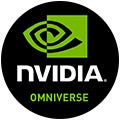How to Get Started Building Digital Twins With an Interactive Warehouse
Developing simple, powerful extensions for customized use cases is easy with NVIDIA Omniverse
By: Grace Metri, Senior Product Manager, NVIDIA
The next evolution of the internet has arrived in the form of the metaverse. 3D creators, developers, and enterprises that make up its pioneers are eagerly pushing the metaverse’s boundaries with digital twins and simulations that re-define what is possible. As industries across the globe pivot resources to build in the metaverse, developers are looking for ways to build custom tools and applications to optimize industry-specific workflows.
NVIDIA Omniverse is an open, scalable reference development platform for 3D simulation and design collaboration that was built to be easily extensible and customizable. While end-users and content creators leverage Omniverse to connect and accelerate their workflows, developers can plug into the platform layer of the Omniverse stack to easily build new tools and services for their unique use cases.
To help developers understand what assets are available for quickly building customized extensions in Omniverse, NVIDIA Technology Intern and a graduate student at Harvard University, Vishal Vaidhyanathan, created a lightweight extension to easily generate a warehouse digital twin. Warehouses are a key use case for digital twins as companies like Amazon build digital twins to optimize warehouse design and flow, to train more intelligent robot assistants, and gain overall productivity.
A Simple Yet Powerful Extension
Warehouse Creator Extension (v.0.1) offers three options to get started creating a warehouse scene. Users can:
- Generate a simple warehouse shell and put in their own assets.
- Procedurally generate a full warehouse with a diverse set of assets by selecting their preferred layout (U-shaped, I-shaped, L-shaped) and objects like empty racks, filled racks, railings, forklifts, and robots.
- Import their own assets by simply pasting the asset link into the extension.
When bringing custom assets into the warehouse, scene creators can import assets directly in place rather than dragging and dropping them onto the stage. For example, if adding boxes to a scene, the smart import option enables users to import boxes directly onto shelves or other desired locations.
Unveiled last week, the extension is already causing a fervor in the Omniverse community as users experience first-hand just how accessible building digital twins can be. While simple, the extension could prove to be a gateway for powerful technology. Internal teams at NVIDIA are already looking to build on the extension with plans for incorporating robotic simulations and using its framework for other industry use cases.
Unpacking Extension Development
Although still in its development phase, Vishal’s warehouse extension illustrates just how easy it is to get started building extensions with Omniverse Code. An architect by training who’s new to Universal Scene Description (USD) development and building extensions in python, he was able to build the Warehouse Creator over a weekend.
The documentation of Omniverse Code provided a comprehensive template and structure by which Vishal could easily plug in and experiment with code. Vishal used the omni.usd documentation to build the logic of his extension. From the omni.ui documentation, he was able to pull reference snippets for a flexible user interface that allowed him to intuitively lay out the three scene creating options.
He used simple asset-placement rules to control the position and orientation of USD assets on the stage. These assets are referenced from NVIDIA’s Omniverse Nucleus server and placed in corresponding positions controlled by the placement rules. The omni.usd library makes it possible to control USD assets with great ease.
“I hope this shows how easy it is to make extensions in Omniverse,” Vishal said. “The quick access documentation has everything you need to get started.”
To access the extension,
- Open Omniverse Create (From Integration Launcher)
- Open Window > Extensions. In the extensions window, search for Warehouse Creator.
- You can install and enable the extension to get started!
The Power of USD
Vishal also pointed out how the base of USD greatly simplified the process of scene construction. USD is both an open source interchange format for arbitrary 3D scenes, as well as a runtime which provides a rich toolset for reading, writing, editing scenes. Having information about texture, reflections, physics, and weight neatly organized in a file format made it super easy to control objects, and build complex workflows.
USD is far more than a static file format. It’s a 3D composition engine with APIs for composing, editing, querying, rendering, collaborating, and simulating virtual worlds. At its core, USD is an open and extensible language of 3D worlds. NVIDIA Omniverse is a USD platform, a toolkit for building metaverse applications, and a compute engine to run virtual worlds.
Get Started Building Extensions
To get started building extensions on NVIDIA Omniverse, check out the quick start documentation and watch the video on How to Build an Omniverse Extension in Less Than 10 Minutes below.
Developing an Omniverse extension could win you an NVIDIA RTX™ GPU. Enter the #ExtendOmniverse contest for a chance at prizes.
See the Omniverse Developer Resource Center for additional resources, view the latest tutorials on Omniverse, check out the forums for support, join the Omniverse Discord server to chat with the community, don’t miss our community livestreams on Twitch, and subscribe to stay up-to-date on all things Omniverse news.
Want to Build a Digital Twin?
Register free for GTC 2022 to learn about the latest metaverse technologies and how to build a digital twin in NVIDIA Omniverse. You’ll see how to aggregate disparate 3D datasets (i.e., CAD, design, animation, or simulation) from many software ecosystems and visualize them in full-design fidelity with no data loss or model decimation. After, join this interactive support session to get specific questions about your use case answered.
